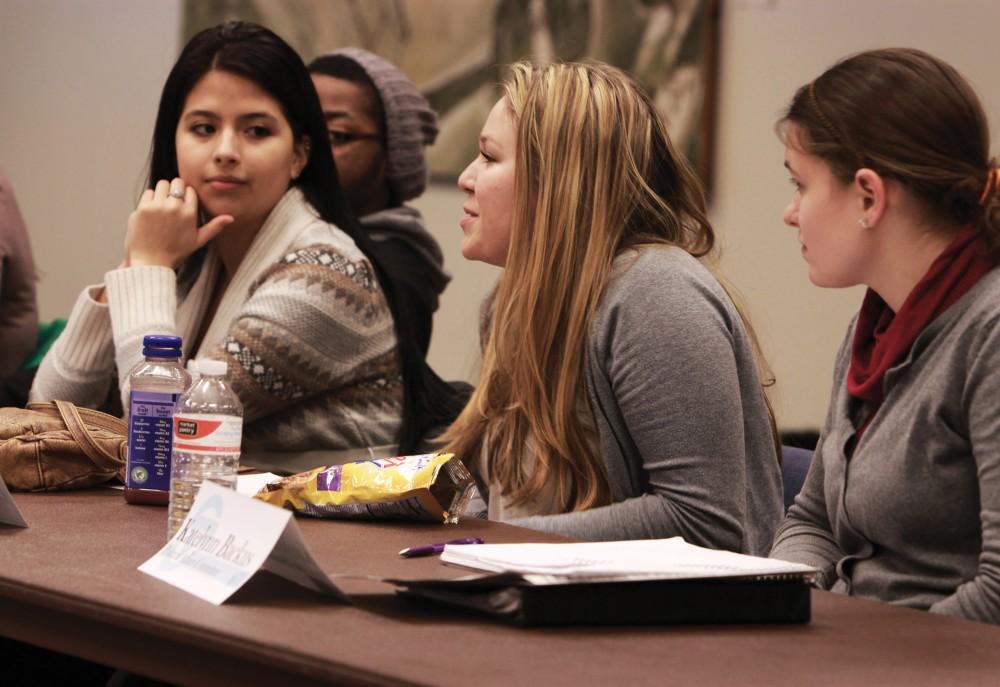Student Senate sets goals for 2014-2015

GVL / Archive Student Senate Meeting
Sep 3, 2014
Audra Gamble
The Grand Valley State University Student Senate held their first general assembly meeting of the academic year on Thursday, Aug. 28. The meeting set the tone for the rest of the year as committee vice presidents outlined their goals for the 2014-2015 school year.
The meeting began with GVSU’s president, Thomas Haas, swearing in all of the senators. Haas called this a rite of passage for the senators.
“You have a very important role to listen to the voice of the students of how we can make GVSU a better place to be,” Haas said. “A better place to learn and a better place to live.”
The Student Senate focused on their plans for the year and each vice president gave a report on what they want to accomplish this year.
Student Senate President Andrew Plague mentioned that a goal of the senate is to become more engaged with graduate students.
The campus affairs committee vice president, Eric Cousins, is focusing on a centralized mobile GVSU app, as well as pushing the city of Allendale to put sidewalks on 48th Avenue. He also wants to prevent bike theft on the Pew Campus.
Scott St Louis, vice president for educational affairs, would like to see a new platform for faculty evaluations that is universal for students.
Vice president for diversity affairs, Rainesha Williams-Fox, plans on creating a registered interfaith organization on campus.
The external relations vice president, Madelaine Cleghorn, will add a downtown location for the Sept. 11 memorial that normally takes place outside of the Kirkhof Center. In addition, she is looking to create more opportunities for civic engagement on campus.
The vast majority of the meeting was taken up by a presentation by Vice Provost and Dean of Students Bart Merkle and Director of Institutional Analysis Phillip Batty. The presentation informed the senators of the makeup of their constituents, the GVSU student body.
Most of the statistics that the senators listened to are often presented to students during tours of the campus, and are thus old hat. However, some of the data was less well-known to the senators. Batty and Merkle noted that the growth in enrollment had slowed from 2008 to 2013, but they expect there to be an increase for the class of 2018.
Additionally, Merkle noted that he is concerned that 83.8 percent of students at GVSU in the 2013-2014 school year were Caucasian.
“That 15 percent of students of color represent years and years of slow growth,” Batty said. “We have done that consistently. For public, four-year institutions in the United States, 28 percent of students are students of color. Clearly, students who attend Grand Valley are going to get their education in an environment that is considerably less diverse ethnically than what they might find elsewhere. The university continues to work on changing that balance.”
In addition to a disparity of diversity, Batty also highlighted a lack of confidence in the female population on campus.
Entering female freshmen tend to have had a slightly higher high school GPA when they enter GVSU, but are less likely to think they will succeed.
“In terms of intellectual self-confidence, 72 percent of male entering students think that they’re above average intellectual self-confidence, compared to 50 percent of female students,” Batty said.
Eighty percent of male students are confident in their academic ability, compared to 66 percent of female students.
“Across any sort of ability, entering male freshmen rate themselves significantly higher than entering female freshmen,” Batty said.
Merkle added that, “the men on campus are not as good as they think they are and the women are quite a bit better then they think they are.”
Batty noted that this is a concern for the university and advised the senators to keep this in mind when dealing with their peers.

























